Agate 9 is the Soviet answer to Apple. Part one
Today I would like to talk about another computer in my home collection, namely about the AGAT-9 PC.
This 8-bit personal computer was developed at the Research Institute of Computer Systems of the USSR (NIIVK). The development was carried out in 1981-1983 under the leadership of chief designer Anatoly Fedorovich Ioffe. And, as always, the computer of foreign production was taken as the basis - the American school computer Apple II.
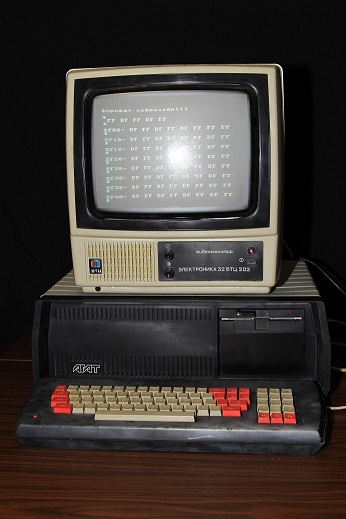
The AGAT PC was mass-produced since 1984 and was first presented at the CeBit 84 exhibition. The latest AGAT series of computers was released in 1993, and, according to information from various sources, in some schools, the use of Agates in the educational process continued at least until 2001.
PC AGAT produced in several versions. Depending on the configuration and design solutions, several modifications are provided: AGAT-4, AGAT-7, AGAT-8, AGAT-9.
')
AGAT-4 was released in the form of a small experimental batch and quickly fell out of use. The AHAT-7 lasted a little longer, differing from its progenitor by a large memory capacity, the presence of floppy disk memory and other minor improvements. The culmination of the creation of domestic manufacturers was the AGAT-9, which had an improved memory management system, additional graphics display modes, and, most importantly, had quite satisfactory compatibility with the Apple II + 64 K computer software.
The basis of AGATA software is the BASIC programming system, based on Apple DOS 3.3 and Applesoft BASIC interpreter. The first software packages for Agat Steel PCs are the Agat-Author text preparation system and the Numerical Simulation System, which is an adaptation and expansion of the VisiCalc program. And chess programs (“Anacephal 1”) and checkers were among the first game programs. Subsequently, the number of software for computers AGAT has reached enormous proportions - database management systems, graphic editors for different graphic modes, new text preparation systems, and of course training programs were developed. In addition to their own development, for the computer AGAT adapted programs and games running on the computer Apple II.
Computers AGAT staffed school classrooms. For training students used the software complex "Schoolgirl", as well as a full-featured operating system based on the RAPIRA language interpreter. The cost of a class of educational computing equipment (KUVT) from 12 or 16 AGAT computers, including one teacher’s computer (which was usually packaged with a printer, and sometimes with increased memory), was 50–65 thousand rubles.
Image source: http://deka18.tsk.ru/
Technical characteristics of PC AGAT-9.
The AGAT computer uses a 6502 processor, which was also used (in addition to the Apple II) in the Pravets 8 , 8-bit Atari , and Dendy computers . Also, under the control of the processor 6502, the robot Bender is a character in the Futuram cartoon series ( proof ).
References and expansion cards.
For Agatha, a number of expansion cards and additional devices were developed. The developments were carried out both by NIIVK engineers and other enterprises, as well as by private individuals. Below is a list of some products:
Photos of various expansion cards, disk drives and PCs AGAT (including motherboards of various modifications and modules of external interfaces) can be found at http://deka18.tsk.ru
Appearance and internal device.
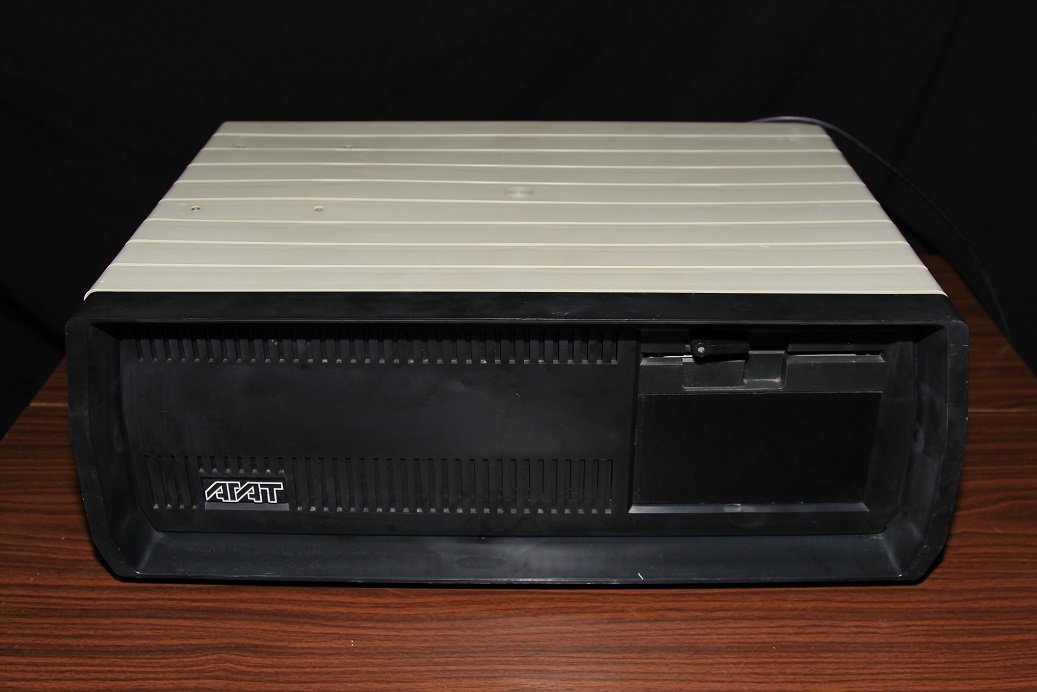
The computer case AGAT-9 is made of plastic. On the front panel there are compartments for two drives: the upper compartment is designed to install a conventional floppy disk drive at 840Kb, and the lower one for a wide floppy drive at 140Kb. In this computer drive 140Kb is not installed.
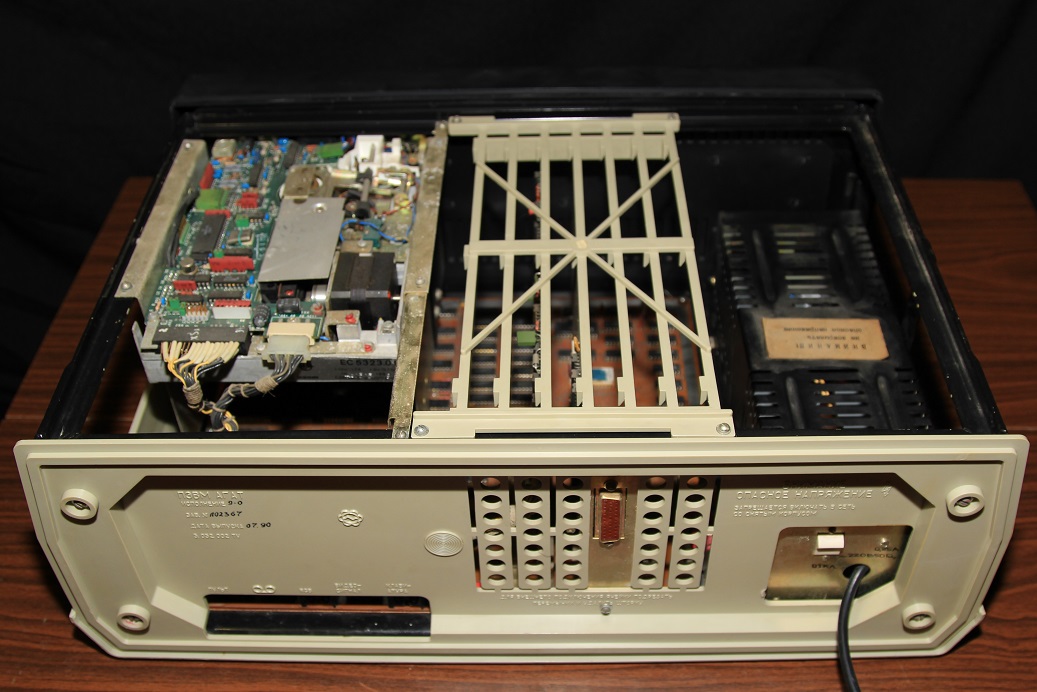
On the back there are connectors for connecting a keyboard, a black and white and color monitor, a tape-recorder connector and a console connector. Six slots for expansion cards and a power button are located there. Expansion cards are fixed with a special plastic cover screwed with four screws to the metal frame of the case.

The dynamic head is attached to the upper case cover.
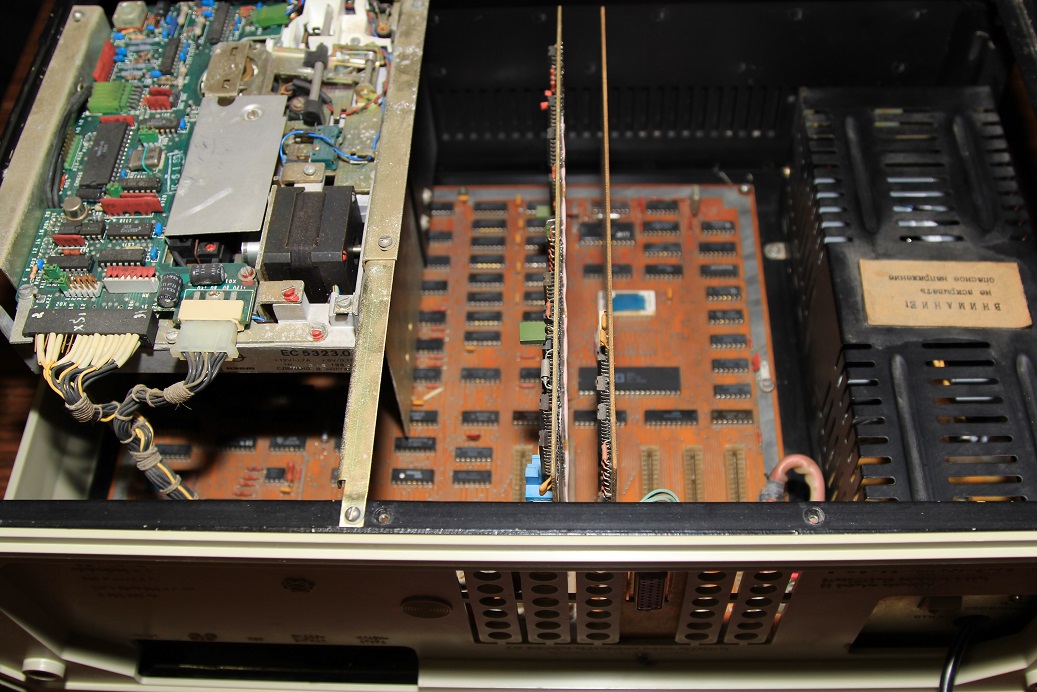
Remove the plastic cover and remove the controllers.
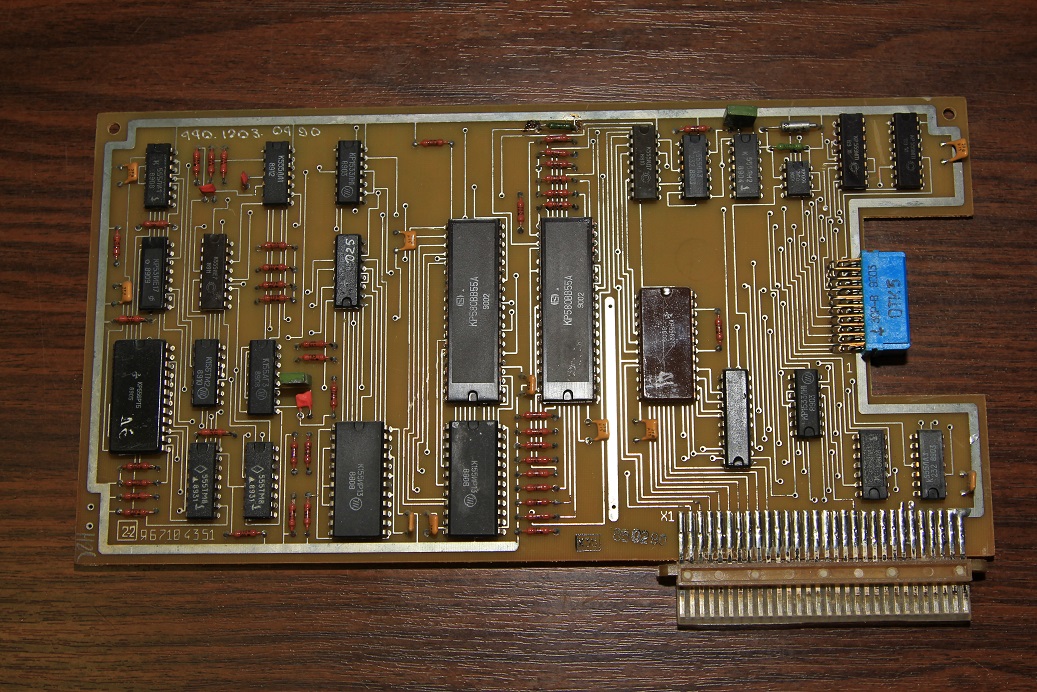
It looks like a floppy disk controller.
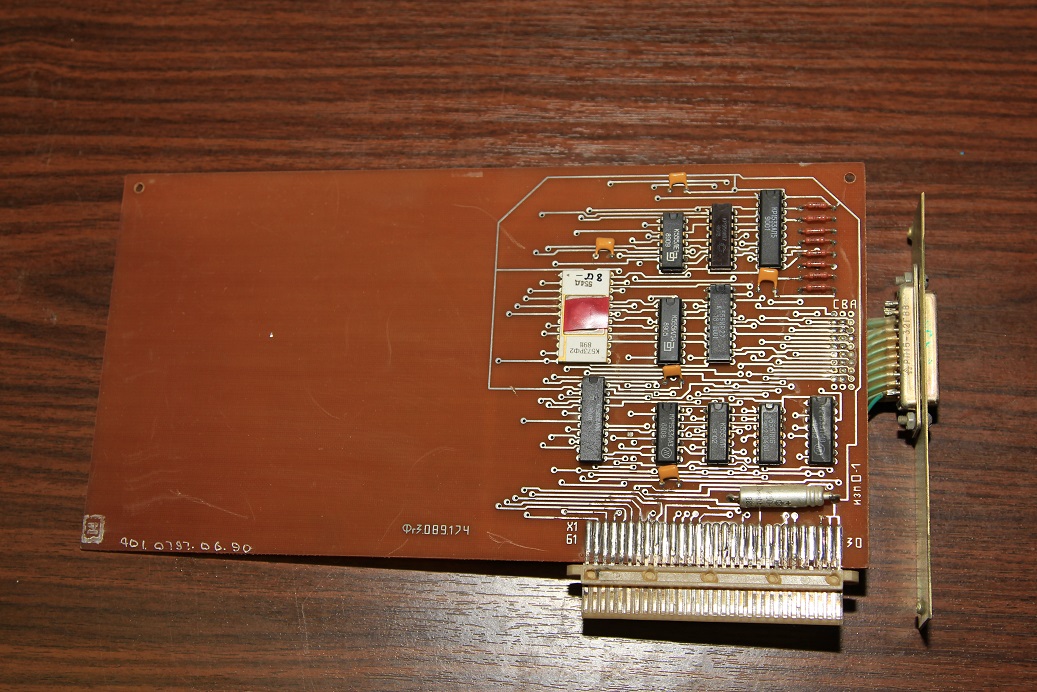
And this is the printer port controller.
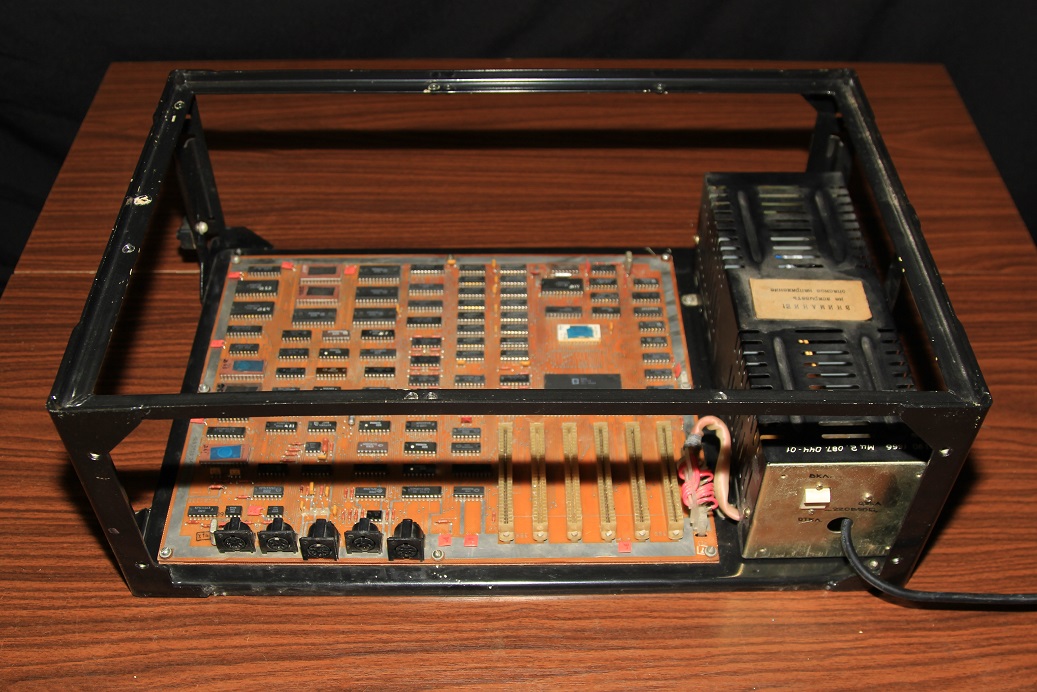
Remove the basket for disk drives. At the same time you can remove all the plastic parts of the case, leaving only one metal frame.

Basket for floppy disk drive with an installed 840Kb drive.

Power Supply.
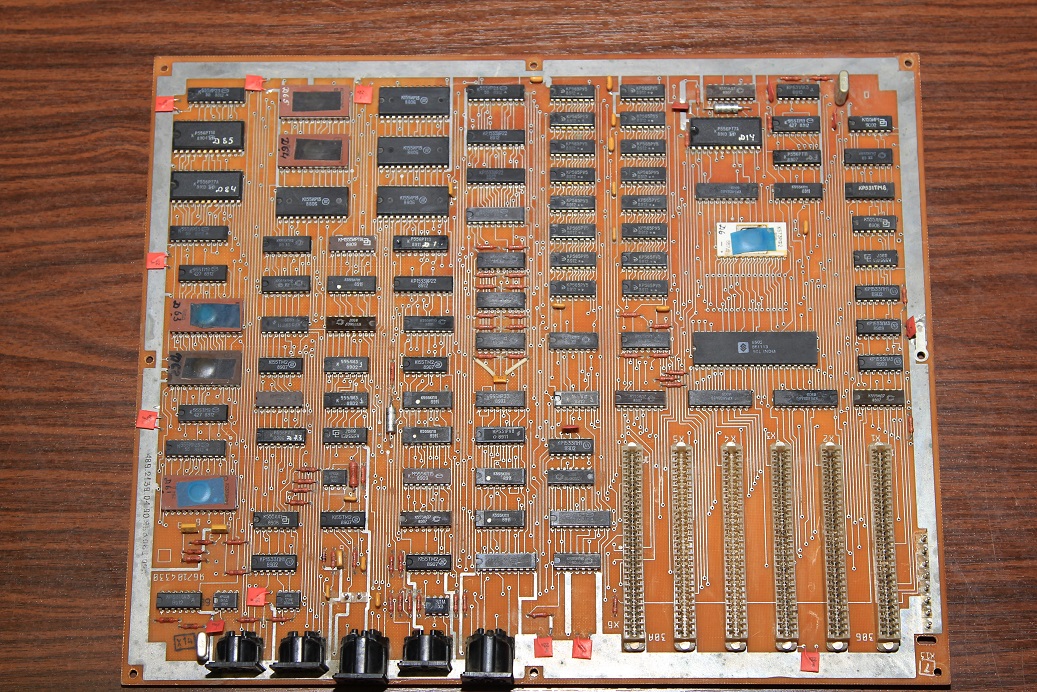
Motherboard.
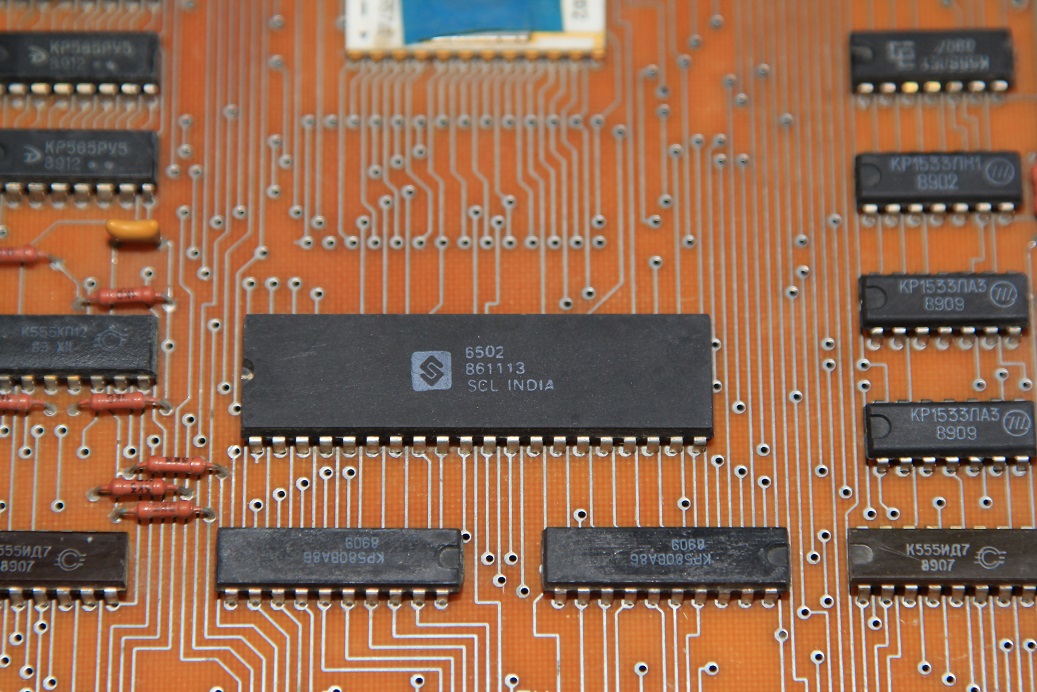
Brains Bender Processor SCL 6502. Made in India!

The memory is recruited by KR565RU5 microcircuits.
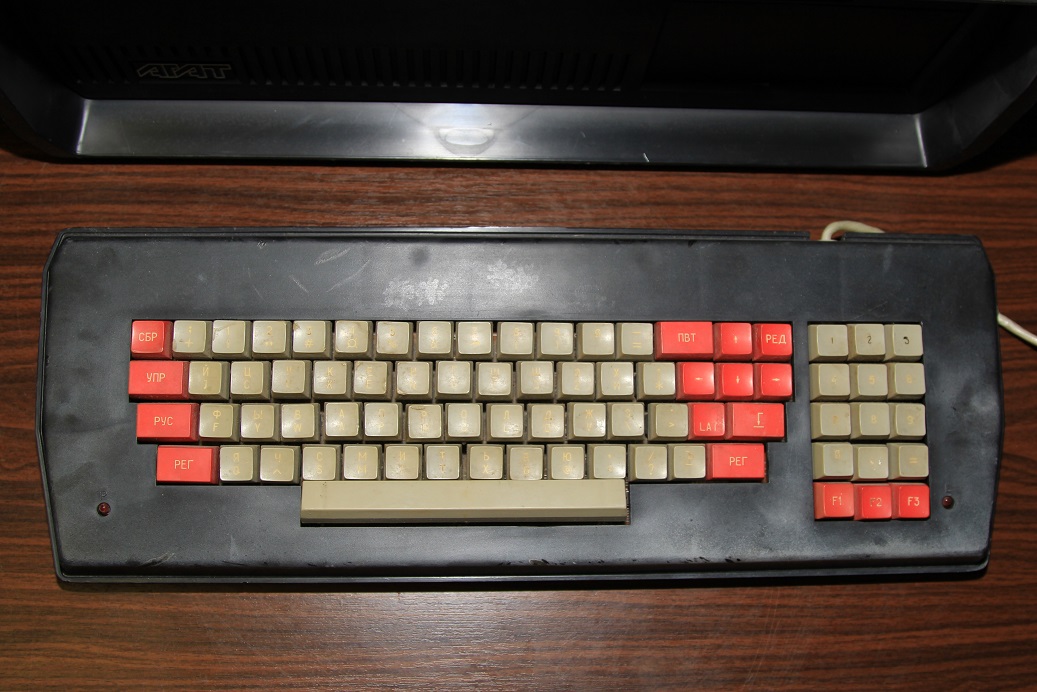
Unpresentable type of keyboard. But it works.
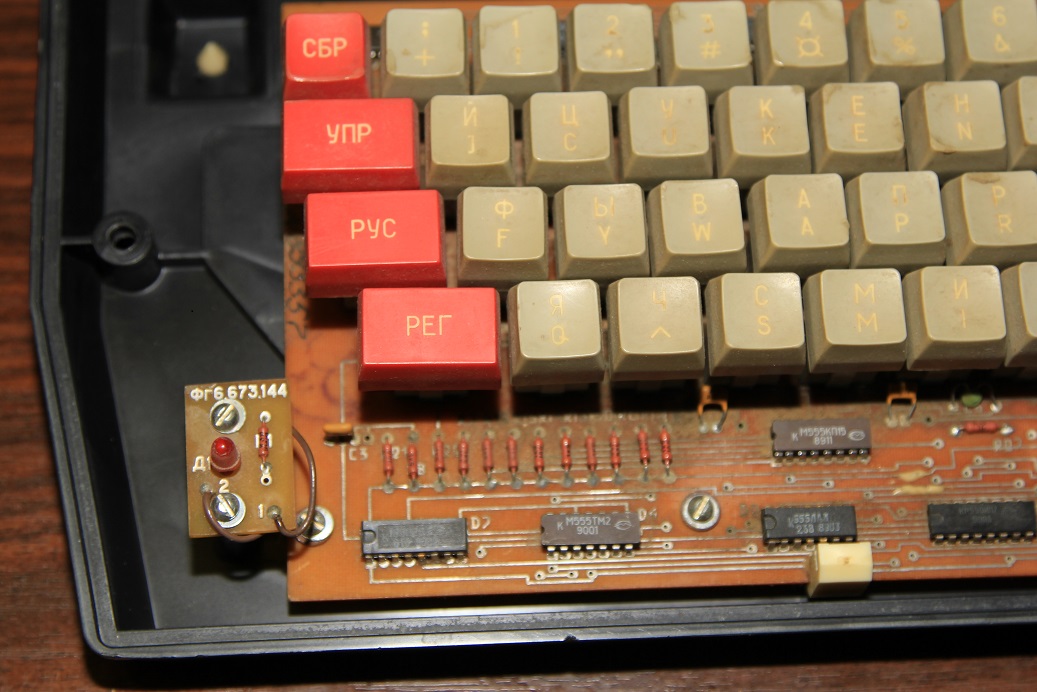
Keyboard also parse. Inside there is a small logic and a sufficient amount of dust.
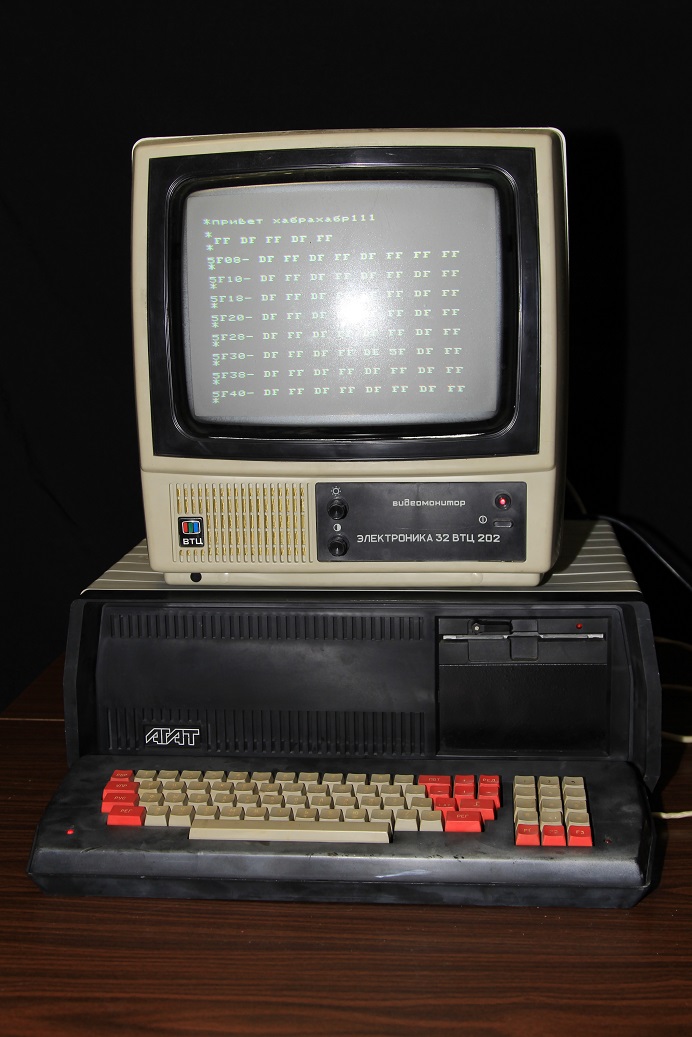
Now we collect everything to the initial state and turn on the computer.
Images of floppy disks with OS and software.
Unfortunately, AGAT-9 got me without floppy disks with the operating system. Since there is no hard disk, Agatu is simply not loaded with anything, so all that can be seen on my machine is the AGAT-9 message at the top of the monitor.
Despite the fact that the Internet is full of floppy images for AGATA with all kinds of software, it is not possible to write them using a floppy disk drive on a regular PC, due to technical features. However, there are as many as two ways to write a floppy disk image on AGATE itself, by connecting it to a personal computer.
The first method is described here , but it did not suit me, since for its work a loaded OS with BASIC on the AGAT computer is required, or at least an “Assembler” from the ICP.
The second method, named by the author Bridge UGMD-PC or Link N 2 , allows you to read and write to the PC agate diskettes without having a live Agata, using only its standard 800kb controller and floppy drive.
The bridge -PC is a software and hardware device connected to the parallel port of a personal computer and allows data transfer between a PC and the controller of the Agata drive with a speed of about 140 kb / s. The bridge NGMD-PC is built on the basis of the ATmega16 controller operating at a frequency of 14.3 MHz, besides it there are several TTL chips on the board, which form a clock generator close to the original Agata generator.
Unfortunately, I was not able to repeat this device, so I will be very grateful to those people who can write for me diskettes with the operating system AGAT-9.
If a miracle happens, and the floppy disks with the OS will be in my hands, the second part of the post about the Soviet PC AGAT-9 will follow, including an overview of the system and application software, as well as computer games running on this machine.
Thanks for attention!
Literature on the subject.
This 8-bit personal computer was developed at the Research Institute of Computer Systems of the USSR (NIIVK). The development was carried out in 1981-1983 under the leadership of chief designer Anatoly Fedorovich Ioffe. And, as always, the computer of foreign production was taken as the basis - the American school computer Apple II.

The AGAT PC was mass-produced since 1984 and was first presented at the CeBit 84 exhibition. The latest AGAT series of computers was released in 1993, and, according to information from various sources, in some schools, the use of Agates in the educational process continued at least until 2001.
PC AGAT produced in several versions. Depending on the configuration and design solutions, several modifications are provided: AGAT-4, AGAT-7, AGAT-8, AGAT-9.
')
AGAT-4 was released in the form of a small experimental batch and quickly fell out of use. The AHAT-7 lasted a little longer, differing from its progenitor by a large memory capacity, the presence of floppy disk memory and other minor improvements. The culmination of the creation of domestic manufacturers was the AGAT-9, which had an improved memory management system, additional graphics display modes, and, most importantly, had quite satisfactory compatibility with the Apple II + 64 K computer software.
The basis of AGATA software is the BASIC programming system, based on Apple DOS 3.3 and Applesoft BASIC interpreter. The first software packages for Agat Steel PCs are the Agat-Author text preparation system and the Numerical Simulation System, which is an adaptation and expansion of the VisiCalc program. And chess programs (“Anacephal 1”) and checkers were among the first game programs. Subsequently, the number of software for computers AGAT has reached enormous proportions - database management systems, graphic editors for different graphic modes, new text preparation systems, and of course training programs were developed. In addition to their own development, for the computer AGAT adapted programs and games running on the computer Apple II.
Computers AGAT staffed school classrooms. For training students used the software complex "Schoolgirl", as well as a full-featured operating system based on the RAPIRA language interpreter. The cost of a class of educational computing equipment (KUVT) from 12 or 16 AGAT computers, including one teacher’s computer (which was usually packaged with a printer, and sometimes with increased memory), was 50–65 thousand rubles.

Image source: http://deka18.tsk.ru/
Technical characteristics of PC AGAT-9.
- Processor: 6502
- Digit capacity: 8 bits
- Clock frequency: 1 MHz
- Productivity: 500 thousand operations / s
- The amount of RAM: 128 KB (expandable to 640 KB)
- External memory: 840 Kb - floppy disk, 140 Kb - floppy disk drive, NML (household tape recorder) - cassette MK-60
- Monitor: MC6105 color "Electronics 32VTTs 201"
- Information display modes:
- text: 32x32, 8 colors, 64x32, 40x24 (monochrome)
- graphic: 512x256, 256x256 (monochrome), 256x256, 4 colors from 16 possible (4 palettes), 128x128, 16 colors, 280x192, 6 colors - Keyboard: external, 74 keys
- Printer: D100 (Poland); CTI CPA-80, CPF-H80 (Japan); Epson FX-85, FX-800, LX-800 (Japan); SM6337, MS6313 (USSR)
- The package included two gaming console
- There are 6 plugs to install expansion modules
- Dimensions (without external devices): 500x351x195 mm
- Weight (without external devices): 9 kg
- Power consumption (without external devices): 60 W
The AGAT computer uses a 6502 processor, which was also used (in addition to the Apple II) in the Pravets 8 , 8-bit Atari , and Dendy computers . Also, under the control of the processor 6502, the robot Bender is a character in the Futuram cartoon series ( proof ).
References and expansion cards.
For Agatha, a number of expansion cards and additional devices were developed. The developments were carried out both by NIIVK engineers and other enterprises, as well as by private individuals. Below is a list of some products:
- Module LAN (NIIVK). Designed to create a local area network based on PC Agat-7 and Agat-9. A peer-to-peer network is provided for up to 127 subscribers (PC Agat-7 and Agat-9) at a distance of up to 1000 m, with a transmission speed of up to 62 kbaud.
- Module "Styk-2" (NIIVK). Software and hardware tools for machine-to-machine communication via the RS-232 interface ("JOINT C2").
- Controller card NMD "Card-93" (NTK "Sprite"). Built on the basis of the IC 1818VG93 (WD1793), it was possible to read diskettes recorded on DVK, PC, Spectrum computers.
- Hard disk controller (Sprite NTC). Built on the basis of IC 1809VG7 (i82062), designed to work with MFM type hard disks. Work with HDD was supported from the side: "Sprite-OS", OS of local network (IKP-1), KPON ("Schoolgirl", "Agat-author", BASIC).
- "Nippel Clock Card" ("Nipple"). Built on the basis of IC 512VI1 (MC146818), includes a lithium battery. Provides a continuous countdown and non-volatile storage of parameters (analogue of the "CMOS" IBM PC);
- Manipulators "mouse". Manipulators UVK-01 "Martian" and MM8031 from PC "Corvette" were connected. With the help of a motherboard based on the 1816BE35 microcontroller, “mice” from a PC (NTC Sprite) could be connected. Mouse control was supported by a number of software products, including graphic editors: “Markis”, “MouseGraf”;
- Modem AM1200. Telephone modem providing communication between PC Agat or PC. Exchange rate - 1200 baud. The modem is supplied with a program for messaging between Agat users in the “Chat” mode;
- Light pen "Agate-pointer". It is intended to provide an indication function when equipping a PC Agat with a large demonstration monitor.
Photos of various expansion cards, disk drives and PCs AGAT (including motherboards of various modifications and modules of external interfaces) can be found at http://deka18.tsk.ru
Appearance and internal device.

The computer case AGAT-9 is made of plastic. On the front panel there are compartments for two drives: the upper compartment is designed to install a conventional floppy disk drive at 840Kb, and the lower one for a wide floppy drive at 140Kb. In this computer drive 140Kb is not installed.

On the back there are connectors for connecting a keyboard, a black and white and color monitor, a tape-recorder connector and a console connector. Six slots for expansion cards and a power button are located there. Expansion cards are fixed with a special plastic cover screwed with four screws to the metal frame of the case.

The dynamic head is attached to the upper case cover.

Remove the plastic cover and remove the controllers.

It looks like a floppy disk controller.

And this is the printer port controller.

Remove the basket for disk drives. At the same time you can remove all the plastic parts of the case, leaving only one metal frame.

Basket for floppy disk drive with an installed 840Kb drive.

Power Supply.

Motherboard.


The memory is recruited by KR565RU5 microcircuits.

Unpresentable type of keyboard. But it works.

Keyboard also parse. Inside there is a small logic and a sufficient amount of dust.

Now we collect everything to the initial state and turn on the computer.
Images of floppy disks with OS and software.
Unfortunately, AGAT-9 got me without floppy disks with the operating system. Since there is no hard disk, Agatu is simply not loaded with anything, so all that can be seen on my machine is the AGAT-9 message at the top of the monitor.
Despite the fact that the Internet is full of floppy images for AGATA with all kinds of software, it is not possible to write them using a floppy disk drive on a regular PC, due to technical features. However, there are as many as two ways to write a floppy disk image on AGATE itself, by connecting it to a personal computer.
The first method is described here , but it did not suit me, since for its work a loaded OS with BASIC on the AGAT computer is required, or at least an “Assembler” from the ICP.
The second method, named by the author Bridge UGMD-PC or Link N 2 , allows you to read and write to the PC agate diskettes without having a live Agata, using only its standard 800kb controller and floppy drive.
The bridge -PC is a software and hardware device connected to the parallel port of a personal computer and allows data transfer between a PC and the controller of the Agata drive with a speed of about 140 kb / s. The bridge NGMD-PC is built on the basis of the ATmega16 controller operating at a frequency of 14.3 MHz, besides it there are several TTL chips on the board, which form a clock generator close to the original Agata generator.
Unfortunately, I was not able to repeat this device, so I will be very grateful to those people who can write for me diskettes with the operating system AGAT-9.
If a miracle happens, and the floppy disks with the OS will be in my hands, the second part of the post about the Soviet PC AGAT-9 will follow, including an overview of the system and application software, as well as computer games running on this machine.
Thanks for attention!
Literature on the subject.
Source: https://habr.com/ru/post/237789/
All Articles